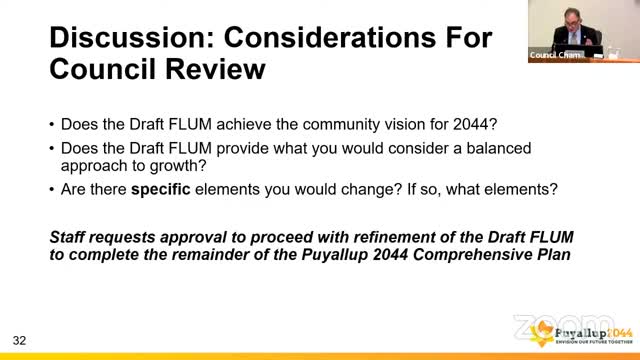Legislation threatens to transform single family neighborhoods
September 17, 2024 | Puyallup, Pierce County, Washington
This article was created by AI summarizing key points discussed. AI makes mistakes, so for full details and context, please refer to the video of the full meeting. Please report any errors so we can fix them. Report an error »

In a recent government meeting, significant concerns were raised regarding House Bill 1110, which mandates the allowance of up to six housing units on a single residential lot. This legislation, aimed at addressing housing shortages, has sparked fears among community members about the potential transformation of single-family neighborhoods into high-density rental areas.
Critics of the bill argue that it will lead to the division of lots in older neighborhoods, effectively doubling the number of homes and potentially increasing the number of vehicles in these areas. One speaker highlighted that the bill could result in up to 12 cars for a single home, raising concerns about parking and infrastructure strain. The legislation also allows for the construction of two accessory dwelling units (ADUs) on each lot, further intensifying the density.
The discussion pointed out that the burden of these changes would disproportionately affect older neighborhoods, while developments governed by homeowners' associations (HOAs) would be exempt from these requirements. This has led to accusations of classism, as wealthier areas could maintain their single-family designations while lower-income neighborhoods face increased density and potential rental conversions.
City officials responded by assuring that zoning regulations would still apply, including considerations for critical areas such as wetlands and steep slopes. However, they acknowledged that there are no parking requirements within a quarter mile of major transit centers, which could exacerbate congestion issues.
Concerns were also raised about the city's infrastructure capacity to support the anticipated growth. Officials indicated that ongoing assessments of utility and transportation plans would be conducted to ensure that the city can accommodate the changes mandated by the new legislation.
As the community grapples with the implications of House Bill 1110, the conversation continues about balancing the need for increased housing with the preservation of neighborhood integrity and infrastructure sustainability.
Critics of the bill argue that it will lead to the division of lots in older neighborhoods, effectively doubling the number of homes and potentially increasing the number of vehicles in these areas. One speaker highlighted that the bill could result in up to 12 cars for a single home, raising concerns about parking and infrastructure strain. The legislation also allows for the construction of two accessory dwelling units (ADUs) on each lot, further intensifying the density.
The discussion pointed out that the burden of these changes would disproportionately affect older neighborhoods, while developments governed by homeowners' associations (HOAs) would be exempt from these requirements. This has led to accusations of classism, as wealthier areas could maintain their single-family designations while lower-income neighborhoods face increased density and potential rental conversions.
City officials responded by assuring that zoning regulations would still apply, including considerations for critical areas such as wetlands and steep slopes. However, they acknowledged that there are no parking requirements within a quarter mile of major transit centers, which could exacerbate congestion issues.
Concerns were also raised about the city's infrastructure capacity to support the anticipated growth. Officials indicated that ongoing assessments of utility and transportation plans would be conducted to ensure that the city can accommodate the changes mandated by the new legislation.
As the community grapples with the implications of House Bill 1110, the conversation continues about balancing the need for increased housing with the preservation of neighborhood integrity and infrastructure sustainability.
View full meeting
This article is based on a recent meeting—watch the full video and explore the complete transcript for deeper insights into the discussion.
View full meeting
